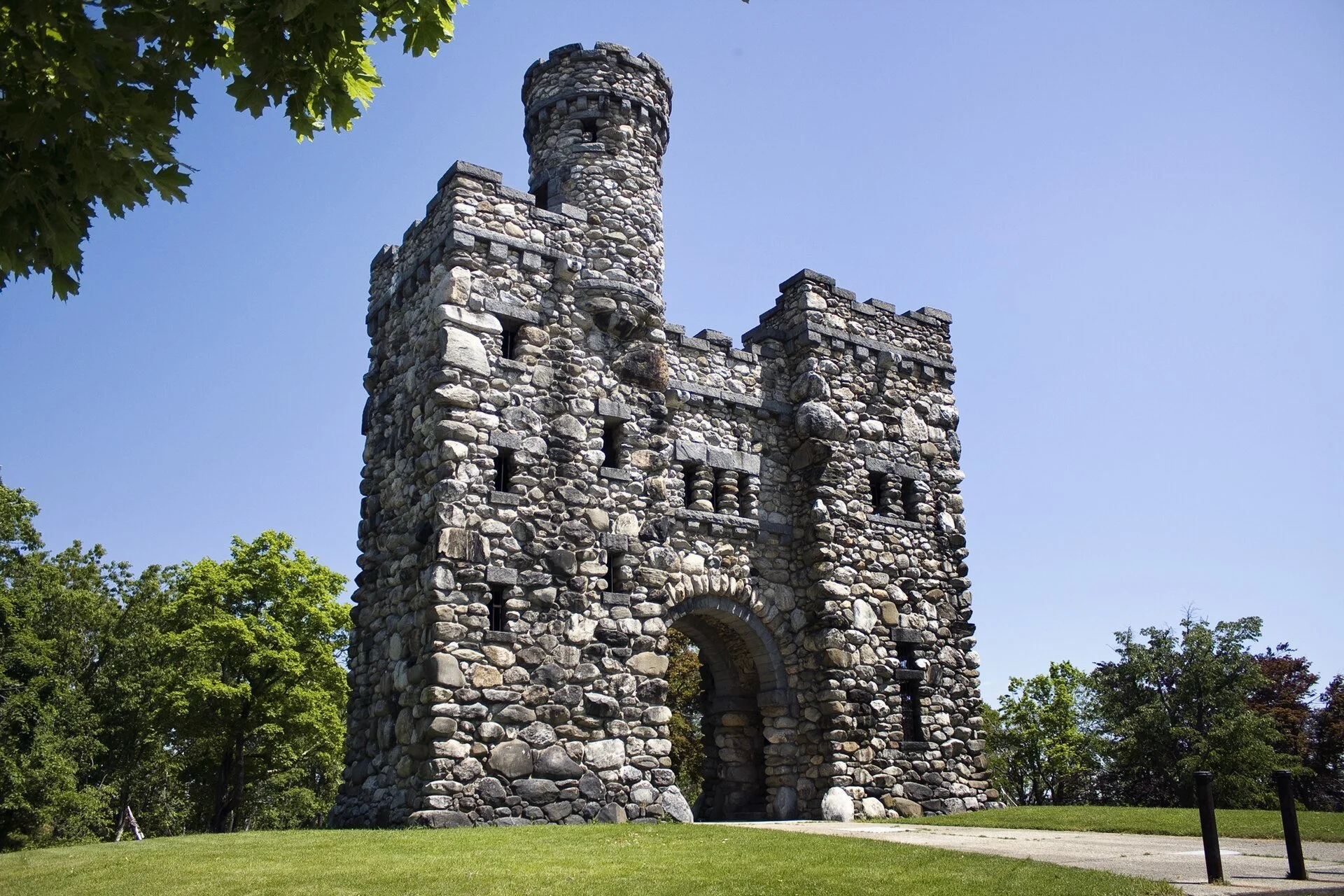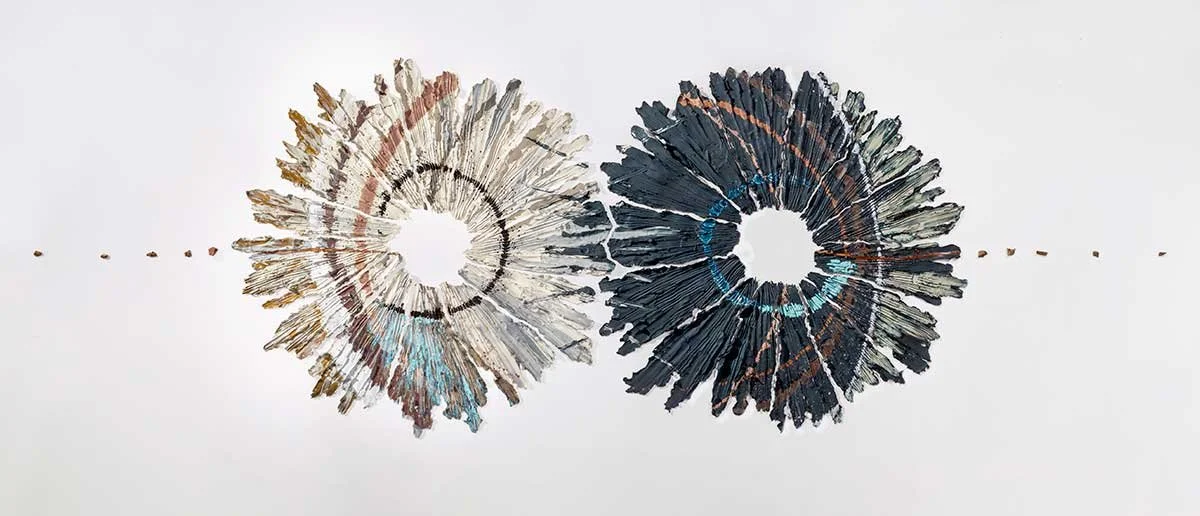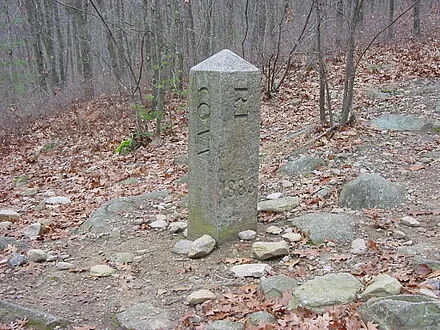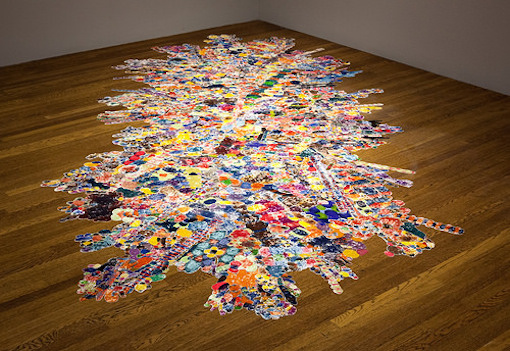
Turbulent world
“Cyano-Collage 191,’’ (collaged cyanotypes and Xuan paper with acrylic gel and acrylic, mounted on aluminum board), by Wu Chi-Tsung, at the Worcester Art Museum
Bancroft Tower Castle, in Worcester
— Photo by Anatoli Lvov
‘False binaries’
“Uncontrollable Drifting Inward and Outward Together (130lbs times two)” (gazed stoneware, rocks, hardware), by Brie Ruais, at the Worcester Art Museum.
— Image courtesy of the artist and Abertz Benda, New York | Los Angeles. Photo by Nash Baker.
The artist says:
“I see these as a balancing of opposites, a kind of turning of the cosmic sphere, night and day, sun and moon, dark and light; false binaries that suggest one can be had without the other, but they reaffirm each other, and coexist in balance (with effort).’’
The Star on the Sidewalk, in front of Worcester City Hall, indicates the spot of what is said to be the first reading in New England of the Declaration of Independence, in 1776.
Who will fall over first?
“Old Friends” (water color and opaque watercolor over old graphite), by Winslow Homer (1836-1910) in the “Watercolors Unboxed” show at the Worcester Art Museum, through Sept. 10. He was one of New England’s greatest painters.
‘The Floating World’ in Worcester
“Old View of the Eight-plank Bridge in Mikawa Province (Mikawa no Yatsuhashi no kozu)”, about 1833-34, (woodblock print; ink and color on paper), by Katsushika Hokusai, in the John Chandler Bancroft Collection, at the Worcester Art Museum. Its part of the show, through March 5 ,called “The Floating World: Japanese Prints from the Bancroft Collection”.
The museum says:
“This winter, travel hundreds of years through one of the most culturally abundant periods in world history. ‘The Floating World’ illustrates the beauty of everyday life through 50 Japanese woodblock prints from the museum’s collection, 48 of which are displayed for the first time. The exhibition pulls directly from WAM’s Bancroft Collection of over 3,700 Japanese prints—the first collection of its kind in the United States.
“‘The Floating World’ focuses on ukiyo-e artworks, a diverse genre created throughout Japan’s Edo period (1603-1868). Translating as ‘pictures of the floating world,’ ukiyo-e prints often depict scenes of leisure and arts regularly enjoyed by the working class during an age of great economic growth. These prints tell stories in the form of intricate tableaus portraying courtesans, kabuki actors, sumo wrestlers, dwellings, and landscapes. Intricate and colorful, ukiyo-e prints center themes like resilience and pride, ideas we celebrate today.’’
Seeking balance in the natural world
“All In Together III” (watercolor and mixed media on paper), by Thompson, Conn.-based artist Susan Swinand in her show “Nature Imagined,’’ at the Worcester Art Museum through Feb. 7
The museum says: “Swinand has a fondness for the natural world and a desire to find the balance between opposing natural forces. ‘Nature Imagined ‘ explores her creative process, which involves letting her materials take on their own form and tapping into her subconscious to make meaning.’’
Thompson, in Connecticut’s “Forgotten Corner,’’ is remarkably rural. This marker in the woods shows where Connecticut, Massachusetts and Rhode Island meet.
.
A proposed community arts center for Worcester
The Worcester Art Museum from the Salisbury Street side. The distinguished museum has 38,000 art objects. It was built in 1898, in the heyday of Worcester’s industrial prosperity, which created some big fortunes and art patrons.
From The New England Council (newenglandcouncil.com)
The University of Massachusetts Memorial Health Center recently announced a $500,000 contribution to Creative Hub Worcester, a proposed community arts center. UMass Memorial stated that the investment in the project is to help improve the mental and emotional health of the Worcester community through creative expression.
The Creative Hub was founded by artists Stacy Lord and Lauren Marotta, who were $850,000 short of their fundraising goal, but have now been able to begin construction thanks to a flurry of recent contributions to the project. The Worcester Creative Hub will transform a former Boys and Girls Club into an event center, art studios, and child-care spaces. The goal of the center is to create a space for artistic expression and community well being.
“This project, this is health to me,” UMass Memorial Health Care President and CEO Dr. Eric Dickson said. “When I see the beautiful place that people are going to be able to come to, the events that will be occurring here in a part of the city that really needs some help, this is what we are committed to doing in addition to providing the great care to the patients we serve.”
The New England Council applauds UMass Memorial Health Center for this investment into the social, emotional and creative wellbeing of the Worcester community. Read more from MassLive and the Worcester Business Journal.
Warhol, et al., in Worcester
“Andy Warhol aside Polaroids of Caroline Ireland,‘‘ about 1979 (digital inkjet print), by Rowland Scherman. (Gift of Howard G. Davis, III A.K.A. David Davis, 2011.162.) © Rowland Scherman, in the Worcester Art Museum’s new show “Photo Revolution: Andy Warhol to Cindy Sherman,’’ which starts Nov. 16. The museum says the show “explores in depth the symbiotic relationship between photography and contemporary art and traces the work of iconic artists from the 1960s to the 1980s.’’
Heroic sculpture in Worcester
“Heroic Bust of Victor Hugo’’ (1802-85 and author of Les Miserables, etc.), by Auguste Rodin (1840-1917), in the show “Rodin: Truth, Form, Life,’’ through April 7 at the Iris and B. Gerald Cantor Art Gallery at Holy Cross College, whose campus looms over the old industrial city of Worcester, which is enjoying a downtown revival. Meanwhile, the surprisingly extensive Worcester Art Museum merits multiple visits.
'And alchemy'
Work by James Dye, in the show "Exploring the Myths of James Dye'' at the Worcester Art Museum, through Sept. 2.
"You couldn't have a culture without a story,'' he told the museum, which presents "several of the literary themes that drive Dye's graphic fictions: creation stories, dystopias and alchemy. ... Dye creates elaborate and imaginative India ink drawings informed by common global narratives.''
A great but troubled patron of Modernism
Scofield Thayer.
Scofield Thayer, a rich man from Worcester, was a central figure in modern literature and visual art, as well as a fascinating case of mental illness. An exhibition of some of the legendary collection he left will be held at the Metropolitan Museum of Art, in New York, July 3-Oct. 7.
From the Met:
"An aesthete and scion of a wealthy family, Scofield Thayer (1889–1982) was co-owner and editor of the literary magazine the Dial from 1919 to 1926. In this avant-garde journal he introduced Americans to the writings of T. S. Eliot, Ezra Pound, D. H. Lawrence, Arthur Schnitzler, Thomas Mann, and Marcel Proust, among others. He frequently accompanied these writers' contributions with reproductions of modern art. Thayer assembled his large collection of some six hundred works—mostly works on paper—with staggering speed in London, Paris, Berlin, and Vienna between 1921 and 1923. While he was a patient of Sigmund Freud in Vienna, he acquired a large group of watercolors and drawings by Schiele and Klimt, artists who at that time were unknown in America.
"When a selection from his collection was shown at the Montross Gallery in New York in 1924—five years before the Museum of Modern Art opened—it won acclaim. It found no favor, however, in Thayer's native city, Worcester, Massachusetts, that same year when it was shown at the Worcester Art Museum. Incensed, Thayer drew up his will in 1925, leaving his collection to The Metropolitan Museum of Art. He withdrew from public life in the late 1920s and lived as a recluse on Martha's Vineyard and in Florida until his death in 1982.''
To read about the collection, please hit this link.
Chinese imperial decadence
"Ming Huang and Yang Gueifei Listening to Music" (detail, ink and light color on silk; early Ming (Chinese) Dynasty), in the show "Dangerous Liaisons,'' at the Worcester Art Museum through April 22.
The show's curator writes:
"The exhibition is centered around the museum's Ming period handscroll painting titled "Ming Huang and Yang Guifei Listening to Music." The Tang Dynasty emperor, Ming Huang, ruled from 712-756 and his fateful love affair with and marriage to the young consort, Yang Guifie, became an enduring tale of love and tragedy.''
Through the centuries this tale has captivated poets as well as other writers and visual artists in both China and Japan. "Dangerous Liaisons Revisited" examines the story's appeal through works from the 7th to the 21st Century; each offering a different interpretation of the event and exploring the Tang Dynasty itself, ''an era marked by imperial decadence and sensuality. ''
We could use one
"The Life Line, 1884 ( oil on canvas), by Winslow Homer, in the show "Coming Away: Winslow Homer and England,'' at the Worcester Art Museum, through Feb. 4. Of course he was most famous for his paintings of New England scenes.
Worcester people of color, 1897-1917
From "Rediscovering an American Community of Color: The Photographs of William Bullard,'' at the Worcester Art Museum, through Feb. 25. Mr. Bullard took pictures of people of African-American and Native-American descent in Worcester in 1897-1917.
Heaven and hell in colonial art
From the show "Highest Heaven: Spanish and Portuguese Colonial Art From the Collection of Roberta and Richard Huber,'' at the Worcester Art Museum, through July 9.
In some ways Worcester is wonderful
Inside the Worcester Art Museum, the second-largest art museum in New England. It was founded in 1898, in Worcester's industrial heyday.
Adapted from an item in Robert Whitcomb’s Dec. 15 “Digital Diary,’’ in GoLocal24.com.
Worcester, which I have always seen as “New England’s Pittsburgh’’ because of its metal-related companies, is enjoying a revival, including in manufacturing, which first made it rich. Indeed, in a recent three-year period, the Worcester area’s manufacturing sector grew 15 percent as measured by revenue.
The city also has numerous higher-education institutions that are contributing to its renaissance, but probably the University of Massachusetts Medical Center has been the most important, helping to turn the city into a major biomedical center. Further, there are big redevelopment projects underway downtown. Some of the revival is simply the westward expansion of the booming Greater Boston economy but some of it is due to healthy homegrown boosterism.
And there are such distinguished cultural centers as the Worcester Art Museum and some gorgeous suburbs, such as Princeton and Harvard, Mass.
Worcester has plenty of problems, of course, but its recent success is edifying for other mid-size cities, in New England and beyond. If only its winters were tad milder. Some of the city is around 1,000 feet above sea level, which makes for considerably more snow and ice than in, say, Boston, Hartford and Providence.
By the way, Worcester is somewhat misleadingly called “the second-biggest city in New England,’’ with a population of about 181,000, compared to Providence’s about 180,000, but the latter’s metro area has many more people than Worcester’s – about 1.3 million compared to Worcester’s about 800,000. Worcester proper has far more square miles, at 38.6, than Providence’s 20.6.
Like Boston and some other Colonial-era towns, Providence’s area is small because other towns in its area were quickly incorporated well before Providence could absorb their acreage as its population and economy boomed in the 19th Century. Consider that while the population of Boston itself is about 667,000, its metro area has about 4.7 million people (or "souls,'' as people used to say).
Out west, on the other hand, cities, such as Phoenix, could easily gobble up vast stretches of unincorporated and under-populated land – much of it effectively wasteland.
The hour approaches
"The Last Judgment Tapestry'' at the the Worcester Art Museum through Sept. 18.
This 16th Century tapestry has 100 nearly life-size figures. There are parts of Worcester in which it appears that the wrath of God has already been exercised.
'Fallen paintings'
"Blow-Up'' (crushed synthetic velvet, fabric dye, 1997), by POLLY APFELBAUM, in the show "Nevermind: Work from the 90s,'' at the Worcester Art Museum, through March 1.
Ms. Apfelbaum thinks of this sort of work as opening up a new conceptual and physical space for painting and sculpture.
She calls it "fallen paintings,'' which are "poised between painting and sculpture.'' And she says that the floor can be an interesting place for art, since, among other things, " belongs to domesticity, the place where your dirty clothes go.''




















